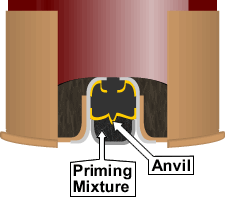- 01: Introduction
- 02: History
- 03: Propellants, Firearms, and Ammunition Development
- 04: Modern Firearms Manufacture
- 05: Small Arms Ammunition
- 06: Evidence Handling Procedures
- 07: Equipment and Instrumentation
- 08: Examination of Firearms
- 09: Cartridge and Shotshell Examination
- 10: Characterization and Evaluation of Fired Projectiles
- 11: Bullet Comparison and Identification
- 12: Gunshot Residue and Distance Determination
- 13: Toolmark Identification
- 14: Communicating Results
- Resources


Priming and Loading
Home > Small Arms Ammunition > Shotshell Assembly > Priming and Loading

For safety reasons, most shotshell priming is performed after case manufacture but prior to loading. This sequence order separates primers and their residue from the propellant charging operation. A primed case is significantly less hazardous than a large quantity of sensitive primers.
Priming machines rotate cases to stations; the primer is fed into position then seated with a punch. The primer-seating punch is designed to push against the sturdy, protective battery cup, leaving the primer cup untouched. This method improves consistency of seating depth and reduces misfire rates. Testing for missing, tipped, and deformed primers may be automated in more modern facilities.
Loading
Loading a shotshell is similar to loading other cartridges, but with a number of additional considerations:
- The propellant selected for powder charging must be consistent with the requirements of shotshells.
- Appropriate wadding material must be inserted within the casing.
- An appropriate projectile(s) must be selected for loading (small pellets, buckshot, or solid projectiles).
- The end of the case must be crimped to keep the contents intact.
Modern high-volume loading machines assemble appropriate propellants, wads, and projectiles in a variety of gauges suitable for many diverse purposes (sporting, police and military use).




